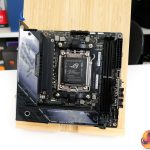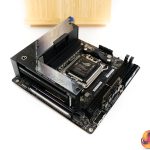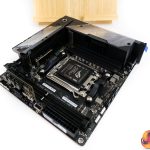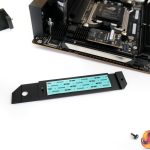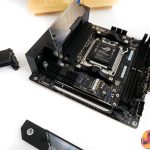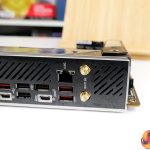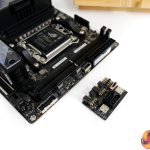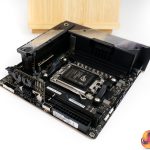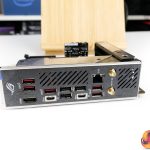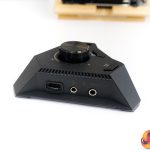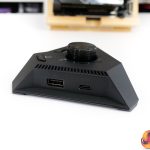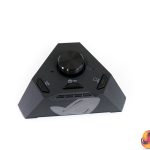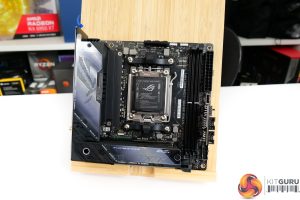Now, we will take a look at the Mini-ITX ROG STRIX X670E-I Gaming WiFi. This will be one for all you small form factor enthusiasts out there. Around the £460-or-so price point is where this board currently sells in the UK.
It’s easy to see even at quick glance just how much connectivity ASUS has squeezed into this diminutive motherboard.
Firstly though, we can look at the power delivery solution. ASUS has deployed a 10+2 stage setup using 110A hardware per stage. While you do get a decent sized heatsink and backplate to cool the MOSFETs, there is a VRM fan that is probably a smart addition for a motherboard intended for SFF usage. PWM control is handled by the Digi+ ASP2205 controller.
Obviously, there’s just the single PCIe 5.0 x16 slot that is intended for graphics card usage, but further connectivity comes via the stacked M.2 connections.
ASUS actually provides installation capacity for two M.2 SSDs, one of which will run at PCIe 5.0 x4 from the CPU’s lanes. A small fan shifts air from the rear IO area to help cool these two stacked SSDs.
And for other connectivity, there’s an add-on card that connects via two pseudo USB Type-C connectors to offer two SATA ports, dual USB 2.0 headers, and front panel connections.
The internal USB 3.2 Gen 2 Type-C header runs at 10Gbps and there’s also a 5Gbps USB 3.0 header. Three 4-pin fan headers along the board’s top edge seems like a reasonable number for a Mini-ITX system, as does the pair of RGB headers, one of which is Addressable.
Once again, dual 40Gbps USB4 ports from the Intel JHL8540 controller are star of the rear IO show. These are absolutely ideal for a Mini-ITX system, too, whereby high-speed external connectivity to an eGPU or fast storage could be crucial.
Another eight USB Type-A ports are featured, five of which run at 10Gbps, with the others being USB 2.0. Video comes in the form of HDMI as well as Displayport via the two USB4 connectors. Intel’s I225-V NIC is used for 2.5GbE and there’s also WiFi 6E connectivity.
Rear IO Clear CMOS and BIOS Flashback buttons are two glaring, questionable omissions… on the face of it. As you will note, there is no audio connectivity on the rear IO, either. This is because ASUS hands over those duties to the ROG STRIX HIVE unit.
On that note, though, we should introduce the ASUS ROG STRIX HIVE.
This is a small, external box that can be connected to the system via USB. It provides BIOS Flashback via a USB 2.0 port, as well as an additional 10Gbps Type-C connector.
Also, audio connectivity is handled via this box’s Realtek ALC4050 Codec and ESS Sabre 9260Q DAC. A 3.5mm headphone/mic jack and a barrel-style optical SPDIF output provide physical connectivity.
In theory, I think the ROG STRIX HIVE is a good idea – you get more connectivity where you can probably better access it with a SFF system. With that said, the connection USB cable is way too short for my liking and I also question the logic of a dedicated PBO button beneath the volume dial. That seems like a bit of a waste of a button for most use cases, most of the time.
ASUS’s ROG STRIX X670E-I Gaming WiFi has some cool features for SFF gaming enthusiasts. It also looks to serve up competent hardware via a strong power delivery solution and well-cooled M.2 SSD mounts.
The ROG STRIX HIVE is a unique solution to a real problem. That is, squeezing all the connectivity onto a Mini-ITX board whilst still making it accessible.
 KitGuru KitGuru.net – Tech News | Hardware News | Hardware Reviews | IOS | Mobile | Gaming | Graphics Cards
KitGuru KitGuru.net – Tech News | Hardware News | Hardware Reviews | IOS | Mobile | Gaming | Graphics Cards


